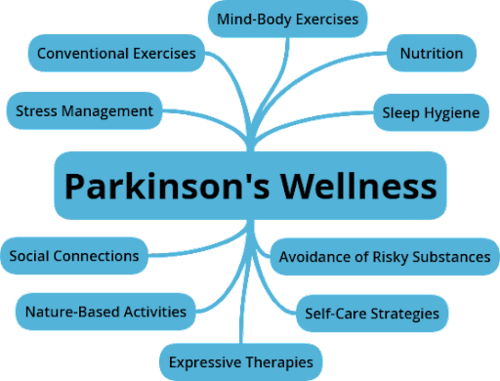Parkinson's Lifestyle Medicine - Art-based or Expressive Therapies and Self Management Strategies
Original Editor - Thomas Longbottom based on the course by Z Altug
Top Contributors - Thomas Longbottom, Kim Jackson, Carin Hunter, Robin Tacchetti, Jess Bell, Tarina van der Stockt, Lucinda hampton and Ewa Jaraczewska
Introduction[edit | edit source]
Approximately 10 million people around the world are currently living with Parkinson’s Disease.[1] Meta-analysis of worldwide data reveals that the prevalence of Parkinson’s Disease increases with age, quadrupling from a level of almost 0.5% in the seventh decade of life to approximately 2% for those over the age of 80.[2] Other sources report that Parkinson's affects 1.5-2% of the population over the age of 60.[3] Parkinson’s is associated with the loss of dopamine-producing neurons in the substantia nigra of the midbrain, and it is typified clinically by resting tremor, rigidity, and bradykinesia along with a number of non-motor features such as anosmia, sleep behaviour disorder, depression, autonomic dysfunction, and cognitive dysfunction.[4] The aetiology of this disease is not fully understood, but there is some combination of environmental and genetic factors presumed to be causative.[4] Among these are various lifestyle factors such as tobacco use, dietary intake, and physical activity.[5][6]

According to the Lifestyle Medicine Handbook, Lifestyle Medicine involves the use of evidence-based lifestyle therapeutic approaches to treat, reverse, and prevent lifestyle-related chronic disease.[8] These include:
- A predominantly whole food, plant-based diet
- Regular physical activity
- Adequate sleep
- Stress management
- Social connections
- Avoidance of risky substance abuse[8]
The aim of Lifestyle Medicine is to treat the underlying causes of disease rather than just addressing the symptoms. This involves helping patients learn and adopt healthy behaviours. Lifestyle interventions have the potential to impact the prognosis of many chronic diseases, leading not only to better quality of life for many but also potentially reducing their costs to the healthcare system.[9] While a tendency to think of Lifestyle Medicine as being the domain of the physician is understandable, other providers such as dietitians, social workers, behavioural therapists and lifestyle coaches are also integral.[9] It is also well within the scope of the physiotherapist, with diet and nutrition being key elements in many of the conditions managed by physiotherapists, with physiotherapists poised as experts in exercise and movement, and with prevention, health promotion, fitness and wellness being crucial aspects of physiotherapy care.[10]
The focus of this module will be on discussing how art-based therapies and self-management strategies for persons with Parkinson's can address anxiety, mood, and stress, and improve physical, cognitive, emotional and social function.
Art-based/Expressive Therapies[edit | edit source]

What are art-based and expressive therapies and how can they be useful for persons with Parkinson's Disease? Art therapy, according to the American Art Therapy Association, is the use of art and the creative process to "explore... feelings, reconcile emotional conflicts, foster self-awareness, manage behavior and addictions, develop social skills, improve reality orientation, reduce anxiety, and increase self-esteem"[11] in order to improve function and well-being. Persons with Parkinson’s can experience blurred vision, dry eyes, and visuospatial perception deficits, potentially leading to limitations with reading, driving, walking, and postural control.[12][11] Preliminary evidence supports that art therapy can produce improvements in visuospatial skills in persons with mild to moderate levels of impairment related to Parkinson’s.[13] Clay art therapy improves hand dexterity, self-expression, mood and quality of life in persons with Parkinson’s.[14] Cognition, functional mobility and gait can be improved in persons with Parkinson’s by music and dance therapy.[15][16] There is some evidence that participation in activities like theater and drum circle classes is beneficial for quality of life in this population.[17][18]
How does one determine which art-based therapy may be right for a person with Parkinson’s Disease? This decision can be based on the impairment being addressed or the specific outcomes desired, such as improvements in visuoperception, mood or depression, dexterity, and quality of life. The clinician should take into account what areas garner the most interest on the part of the patient. Consider also that these interventions may require interdisciplinary collaboration, with referrals to other providers as appropriate.[19]
Self-Care and Self-Management Strategies for Persons with Parkinson's[edit | edit source]
What is self-care/self-management? Self-care can be defined as “the practice of activities that individuals initiate and perform on their own behalf in maintaining life, health and well-being.” Similarly, self-management refers to the behaviours and skills needed for risk factor and chronic condition management on the path to wellness. Key areas for consideration are medication management, physical exercise, self-monitoring techniques, psychological strategies, maintenance of independence, social engagement, and the acquisition, maintenance and application of knowledge. A unique programme in Sweden was designed to offer persons with Parkinson’s and their carers training in self-management, addressing self-monitoring strategies, stress management, education regarding depression and anxiety, education in communication strategies, and instruction for participation in enriching activities. Trainees participated in group sharing of helpful strategies during the program. An accompanying study found that these efforts resulted in improvements in health status and self-management skill among those with the disease.
References[edit | edit source]
- ↑ Statistics [Internet]. Parkinson's Foundation. [cited 2021Dec28]. Available from: https://www.parkinson.org/Understanding-Parkinsons/Statistics
- ↑ Pringsheim T, Jette N, Frolkis A, Steeves TDL. The prevalence of Parkinson's disease: A systematic review and meta-analysis. Movement Disorders 2014;29(13):1583–90.
- ↑ Venes D, Taber CW. Taber's Cyclopedic Medical Dictionary. Philadelphia, PA: F.A. Davis; 2021.
- ↑ 4.0 4.1 Simon DK, Tanner CM, Brundin P. Parkinson Disease Epidemiology, Pathology, Genetics, and Pathophysiology. Clinics in Geriatric Medicine 2020;36(1):1–2.
- ↑ Ritz B, Ascherio A, Checkoway H, Marder KS, Nelson LM, Rocca WA, et al.. Pooled Analysis of Tobacco Use and Risk of Parkinson Disease. Archives of Neurology [Internet] 2007;64(7):990.
- ↑ Paul KC, Chuang Y, Shih I, Keener A, Bordelon Y, Bronstein JM, et al.. The association between lifestyle factors and Parkinson's disease progression and mortality. Movement Disorders 2019;34(1):58–66.
- ↑ Z Altug. Parkinson's Lifestyle Medicine - Nutrition and Sleep Hygiene. Physioplus Course. 2021.
- ↑ 8.0 8.1 Frates B, Bonnet JP, Joseph R, Peterson JA. Lifestyle Medicine Handbook: An introduction to the power of Healthy Habits. Monterey, CA: Healthy Learning; 2021.
- ↑ 9.0 9.1 1. Bodai B. Lifestyle Medicine: A Brief Review of Its Dramatic Impact on Health and Survival. The Permanente Journal 2017;22(1).
- ↑ Worman R. Lifestyle medicine: The role of the physical therapist. The Permanente Journal. 2020;24:18.192.
- ↑ 11.0 11.1 Art as therapy in parkinson's disease [Internet]. APDA. 2019 [cited 2021Dec30]. Available from: https://www.apdaparkinson.org/article/art-therapy-parkinsons-disease/
- ↑ Eye & Vision issues: American parkinson disease assoc. [Internet]. APDA. 2019 [cited 2021Dec30]. Available from: https://www.apdaparkinson.org/what-is-parkinsons/symptoms/eye-vision-issues/
- ↑ Cucca A, Di Rocco A, Acosta I, Beheshti M, Berberian M, Bertisch HC, et al.. Art therapy for Parkinson's disease. Parkinsonism & Related Disorders 2021;84:148–54.
- ↑ Bae Y-S, Kim D-H. The Applied Effectiveness of Clay Art Therapy for Patients With Parkinson’s Disease. Journal of Evidence-Based Integrative Medicine 2018;23:2515690X1876594.
- ↑ Pereira APS, Marinho V, Gupta D, Magalhães F, Ayres C, Teixeira S. Music Therapy and Dance as Gait Rehabilitation in Patients With Parkinson Disease: A Review of Evidence. Journal of Geriatric Psychiatry and Neurology 2019;32(1):49–56.
- ↑ Dos Santos Delabary M, Komeroski IG, Monteiro EP, Costa RR, Haas AN. Effects of dance practice on functional mobility, motor symptoms and quality of life in people with Parkinson’s disease: a systematic review with meta-analysis. Aging Clinical and Experimental Research 2018;30(7):727–35.
- ↑ Modugno N, Iaconelli S, Fiorlli M, Lena F, Kusch I, Mirabella G. Active Theater as a Complementary Therapy for Parkinson's Disease Rehabilitation: A Pilot Study. The Scientific World Journal 2010;10:2301–13.
- ↑ Pantelyat A, Syres C, Reichwein S, Willis A. DRUM-PD: The Use of a Drum Circle to Improve the Symptoms and Signs of Parkinson's Disease (PD). Movement Disorders Clinical Practice 2016;3(3):243–9.
- ↑ Z Altug. Parkinson's Lifestyle Medicine - Art-based or Expressive Therapies and Self Management Strategies. Physioplus Course. 2021.







